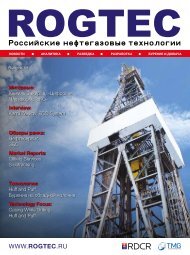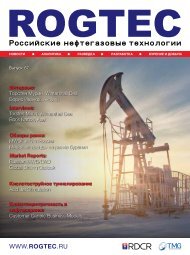ROGTEC Magazine Issue 61
Russian Oli & Gas Magazine
Russian Oli & Gas Magazine
You also want an ePaper? Increase the reach of your titles
YUMPU automatically turns print PDFs into web optimized ePapers that Google loves.
БУРЕНИЕ
Одним из возможных способов решения этой
проблемы является использование системы
бурения с двойной плотностью или, как ее часто
называют, система «бурения с двойным градиентом»
[4]. В отличие от традиционного бурения с одним
градиентом, при бурении с двойным градиентом
используются два гидростатических градиента.
Градиент морской воды от поверхности моря
до морского дна используется для управления
скважиной, а градиент бурового раствора
от морского дна до забоя используется для
обеспечения устойчивости ствола скважины
и удаления из нее шлама. Можно сказать,
что условно, буровая установка находится на
морском дне, поскольку перекрытие толщи воды
уравновешивается градиентом линии морской
воды (рисунок 1 б). Важно отметить, что бурение с
двойным градиентом уже применяется при бурении
пилотного ствола или верхних секции скважин до
установки противовыбросового оборудования (ПВО),
как показано на рисунке 3 А.
Две жидкости внутри кольцевого пространства
могут дать более благоприятный профиль давления
в скважине по сравнению с обычным бурением.
На рисунке 2 показан профиль давлении одной из
глубоководных скважин Черного моря. Система
с двойным градиентом изменяет общий профиль
давления в зависимости от глубины по сравнению
с обычным бурением, обеспечивает большее
окно бурения за счет того, что сдвигает профиль
давления влево (см. таблица 1).
Бурение верхних интервалов, до глубины 2652
метра и 3000 метров, традиционно осуществляется
с выносом выбуренной породы на дно моря (на
рисунке 2 - Бурение с выбросом). После спуска и
цементирования 22” обсадной колонны и установки
райзера с ППВО (подводное противовыбросовое
оборудование), предлагаем бурить с двойным
градиентом давления до 3700 метров. Далее
спустить и цементировать 13 5/8” обсадную колонну
и продолжать бурение сквозь солевой пласт с
двойным градиентом до глубины 4850 метров
(на рисунке 2 - Бурение с двойн. град + MPD 1).
Далее спускается и цементируется 9 5/8” обсадная
колонна, а бурение с двойным градиентом ведется
до конечной глубины 5526 метров (на рисунке 2 -
Бурение с двойн. град. + MPD 2).
Красным пунктирными линиями на рисунке
2 отмечено традиционное бурение с одним
градиентом. При этом способе, количество
несовместимых интервалов выше, поэтому
необходимо спускать 9 обсадных колонн, вместо 5
при бурении с двойным градиентом.
30 ROGTEC
used to secure the stability of the wellbore and to remove
cuttings. Figuratively speaking, the drilling rig is located
on the seabed, since the overlap of the water depth is
balanced with the sea waterline gradient (Fig. 1b). It is
important to note that the dual gradient drilling has been
already applied in drilling of pilot boreholes or upper
sections of wells before the BOP equipment is installed,
as it is shown in Fig.3a.
Two fluids inside the annular space can result in
more favorable well profile pressures compared with
conventional drilling. Fig.2 presents the pressure profile
of one of the deep-water wells in the Black Sea. The dual
gradient system transforms the general pressure profile,
depending on the depth, compared with the conventional
drilling, and provides a greater drilling margin due to
shifting the pressure profile leftward (see Table 1).
The drilling of well’s upper intervals, down to the depth of
2,652 meters and 3,000 meters, is conventionally carried
out with the return of drilling cuttings to the seabed
(Drilling with blowout is presented in Figure 2). After
running and the cementing of the 22” production string
and the installation of risers with submersible blow-out
preventor equipment, we recommend dual gradient
drilling down to 3,700 meters. Hereafter the 13 5/8”
production string is run and cemented, and the drilling
is continued through the salt formation, using the dual
gradient drilling technique, down to the depth of 4,850
meters (Figure 2 illustrates the dual gradient drilling +
MPD1). Thereafter, the 9 5/8” production string is run
and cemented, and the dual gradient drilling is carried
out down to the target depth of 5,526 meters (The dual
gradient drilling + MPD 2 is illustrated in Figure 2).
The single drilling gradient is marked with red dashed
line in Figure 2. Using this technique, there are a
higher number of incompatible intervals; therefore, it is
necessary to run 9 production strings, instead of 5, when
the single gradient drilling technique is used.
The Science and Technology Research of the
Dual Gradient Drilling Systems
The dual gradient drilling is referred to one of the varieties
of the managed pressure drilling (MPD). Let us consider
some systems and technologies used “after the BOP
installation”, which have passed field trials.
Leading western oil companies have invested millions
of dollars during the last 20 years (up to 2011) into the
technologies of the dual gradient drilling, such as:
1. Subsea mud lift pump (SMD);
2. Controlled Mud Pressure system (CMP);
3. Continuous Annular Pressure Management
System (CAPM).
www.rogtecmagazine.com















